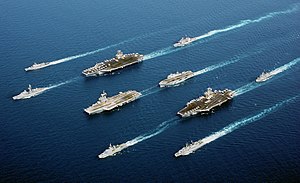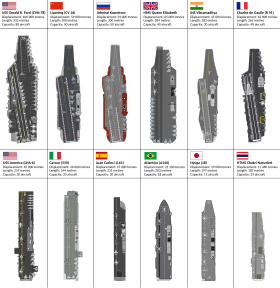
Back Vliegdekskip Afrikaans Portaavions AN Lyftcræftbora ANG حاملة طائرات Arabic Portaviones AST Aviadaşıyıcı Azerbaijani اوچاق داشییان ساواش گمیسی AZB Авианосец Bashkir Авіяносец Byelorussian Авіяносец BE-X-OLD

An aircraft carrier is a warship that serves as a seagoing airbase, equipped with a full-length flight deck and facilities for carrying, arming, deploying, and recovering aircraft.[1] Typically, it is the capital ship of a fleet, as it allows a naval force to project air power worldwide without depending on local bases for staging aircraft operations. Carriers have evolved since their inception in the early twentieth century from wooden vessels used to deploy balloons to nuclear-powered warships that carry numerous fighters, strike aircraft, helicopters, and other types of aircraft. While heavier aircraft such as fixed-wing gunships and bombers have been launched from aircraft carriers, these aircraft have not landed on a carrier. By its diplomatic and tactical power, its mobility, its autonomy and the variety of its means, the aircraft carrier is often the centerpiece of modern combat fleets. Tactically or even strategically, it replaced the battleship in the role of flagship of a fleet. One of its great advantages is that, by sailing in international waters, it does not interfere with any territorial sovereignty and thus obviates the need for overflight authorizations from third-party countries, reduces the times and transit distances of aircraft and therefore significantly increases the time of availability on the combat zone.

There is no single definition of an "aircraft carrier",[citation needed] and modern navies use several variants of the type. These variants are sometimes categorized as sub-types of aircraft carriers,[2] and sometimes as distinct types of naval aviation-capable ships.[3] Aircraft carriers may be classified according to the type of aircraft they carry and their operational assignments. Admiral Sir Mark Stanhope, RN, former First Sea Lord (head) of the Royal Navy, has said, "To put it simply, countries that aspire to strategic international influence have aircraft carriers."[4] Henry Kissinger, while United States Secretary of State, also said: "An aircraft carrier is 100,000 tons of diplomacy."[5]

As of April 2024, there are 47 active aircraft carriers in the world operated by fourteen navies. The United States Navy has 11 large nuclear-powered fleet carriers—carrying around 80 fighters each—the largest carriers in the world; the total combined deck space is over twice that of all other nations combined.[6] As well as the aircraft carrier fleet, the US Navy has nine amphibious assault ships used primarily for helicopters, although these also each carry up to 20 vertical or short take-off and landing (V/STOL) fighter jets and are similar in size to medium-sized fleet carriers. India, the United Kingdom and China each operate two aircraft carriers. France and Russia each operate a single aircraft carrier with a capacity of 30 to 60 fighters. Italy operates two light V/STOL carriers and Spain operates one V/STOL aircraft-carrying assault ship. Helicopter carriers are operated by Japan (4, two of which are being converted to operate V/STOL fighters), France (3), Australia (2), Egypt (2), South Korea (2), China (3), Thailand (1) and Brazil (1). Future aircraft carriers are under construction or in planning by China, France, India, Russia, South Korea, Turkey, and the US.
- ^ "Aircraft carrier", Dictionary, Reference, archived from the original on 19 February 2014, retrieved 3 October 2013
- ^ "Aircraft Carrier", Encyclopaedia, Britannica, archived from the original on 5 October 2013, retrieved 3 October 2013,
Subsequent design modifications produced such variations as the light carrier, equipped with large amounts of electronic gear for the detection of submarines, and the helicopter carrier, intended for conducting amphibious assault. ... Carriers with combined capabilities are classified as multipurpose carriers.
- ^ Petty, Dan. "Fact File: Amphibious Assault Ships – LHA/LHD/LHA(R)". U.S. Navy. Archived from the original on 3 September 2009. Retrieved 15 November 2015.
- ^ "Aircraft carriers crucial, Royal Navy chief warns". BBC News. 4 July 2012. Archived from the original on 25 September 2015. Retrieved 15 November 2015.
- ^ "The slow death of the carrier air wing". jalopnik.com. 19 July 2017. Archived from the original on 11 January 2018. Retrieved 10 January 2018.
- ^ Drew, James (8 July 2015). "US "carrier gap" could see naval air power dip in Gulf region". flightglobal.com. Archived from the original on 17 November 2015. Retrieved 15 November 2015.
© MMXXIII Rich X Search. We shall prevail. All rights reserved. Rich X Search